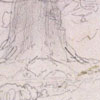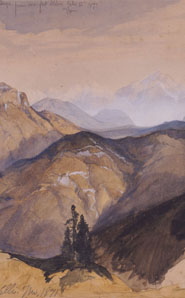|
- Verena Calas, National Park Service Museum Educator, Washington D.C
- 6-8 grades
- 6
[Back to top]
|
- Treasured Landscapes: Virtual exhibit artworks from multiple parks.
- This unit explores how landscape art contributed the preservation and conservation of natural, cultural, and historic places of importance to Americans that are part of the National Park System. These artworks, are owned and preserved by the National Park Service and are locate in the collections of many different parks. This unit includes activities that develop students’ skills of observation, documentation, and analysis. Students will be able to apply these skills to through a real-world application in which they will develop a campaign to conserve and reorganize a significant local site.
- : How did American landscape artists and photographers such as Thomas Moran and William Henry Jackson help to promote the conservation of America’s natural and cultural wonders and establishment of the National Park Service?
- This lesson teaches students how to identify NPS parks by theme and state on a U.S. map. Students will also discuss the relationship between 19th century conservationism, Westward expansion, and the NPS.
- This lesson teaches students how to compare and contrast casual and scientific observation techniques and interpret the field notebook of a Yellowstone botanist. Students will systematically observe and document the geography, plants, and animals of an area.
- This lesson teaches students how to compare and contrast photography, drawing, and painting as visual records while using primary source sketches to identify artistic choices and perception of an artistic subject. Students will also explore the process and tools of traditional film photography.
- This lesson explores who 19th century conservationists worked to establish Yellowstone National Park. Students will conduct a mock interview of a historical figure and write a newspaper article.
-
This lesson explores how landscape painting and photography preserve and convey the significance of historical places.
- In this lesson students will collaboratively design a campaign advocating for the preservation and recognition of a local site.
[Back to top]
|
| This lesson teaches students how to compare and contrast casual and scientific observation techniques and interpret the field notebook of a Yellowstone botanist. Students will systematically observe and document the geography, plants, and animals of an area. |
| MUSEUM OBJECT [photos of objects in the Parks museum collections] |
SIMILAR OBJECTS [local items similar to museum objects] & OTHER MATERIALS |
Length of time |
|
 |
|
The Devil Tower by Thomas Moran |
|
|
|
60
minutes/120 mins (2 days) |
[Back to top]
|
Determine the central ideas or information of a primary or secondary source; provide an accurate summary of the source distinct from prior knowledge or opinions.
Identify aspects of a text that reveal an author's point of view or purpose (e.g., loaded language, inclusion or avoidance of particular facts).
Integrate visual information (e.g., in charts, graphs, photographs, videos, or maps) with other information in print and digital texts.
[Back to top] |
- Student will be able to (SBWAT) Compare and contrast casual and scientific observation skills.
- SWBAT interpret Yellowstone Botanist Field Notebook (content and potential scientific uses).
- SWBAT systematically observe and document the geography, plants, and animals of an area.
[Back to top]
|
See Making a Scene, Background Information PowerPoint
[Back to top]
|
Casual Observation: observing something at the right place and time by a matter of chance or luck.
Specific Observation: observation using tools (sometimes of measurement) and methods of recording what you are looking at.
Yellowstone National Park: America’s first national park established in 1872. Itspans Wyoming, Montana, and Idaho and is known for its abundant wildlife and geysers, including Old Faithful.
[Back to top]
|
|
- Use online collections; objects, documents, maps, and photographs to further student inquiry and to address student learning objectives.
- Activities can be adapted for class length and grade levels.
- Lesson can be split over 2 days, with outdoor activity filling a full class period.
[Back to top] |
- Participation in daily activities.
- Products from Student Activities (Lessons 2-5).
- Individual homework assignments that build towards culminating project.
- Campaign material preparation
- Mounting of campaign material in exhibit
[Back to top]
|
- Produce a 5-10 minute documentary video on a selected local landscape/monument/landmark.
- Create a publicity poster for the student-curated exhibitions
- Use the dates and locations recorded in Thomas Moran’s diary to trace the route of the Hayden expedition. Use maps of Yellowstone to calculate daily distances that Moran travelled.
- Research a recent preservation or conservation controversy at a National Park of your choice (e.g. the reintroduction of gray wolves in Yellowstone).
- Select a National Park or Historic Site and research its designation as a protected site
|
- Anderson, Nancy K. Thomas Moran. Board of Trustees, National Gallery of Art: Washington D.C., 1997.
- Hayden, F.V. Feb 1872. "The Wonders of the West-II: More about the Yellowstone." Scribner's Monthly 3(4). 388-396. (Courtesy of Cornell University Library, Making of America Digital Collection.)http://digital.library.cornell.edu/cgi/t/text/text-idx?c=scmo;idno=scmo0003-4
- Courtesy of Cornell University Library, Making of America Digital Collection. http://digital.library.cornell.edu/cgi/t/text/text-idx?c=scmo;idno=scmo0003-4
- Dobson, G.B. “Wyoming Tales and Trails, featuring photographs and history of old Wyoming.” August 27, 2011. http://www.wyomingtalesandtrails.com/photos2.html. Reviewed September 3, 2013.Manchester, Albert and Ann Manchester, “Hubbell Trading Post National Historic Site: AN Administrative History.” National Park Service, Southwest Cultural Resources Center: Santa Fe, New Mexico, 1993. http://www.nps.gov/hutr/historyculture/upload/HUTR_adhi.pdf
- The National Park Service. “1.3 Criteria for Inclusion.” Management Policies 2006: The guide to managing the National Park System. http://www.nps.gov/policy/mp/policies.html#_Toc157232600
- --------------- “National Park Service Overview.” Informational bulletin, April 2013. http://www.nps.gov/news/upload/NPS-Overview-2012_updated-04-02-2013.pdf
- ------------------. “The National Parks: Shaping the System.” Harpers Ferry Center, National Park Service: Harpers Ferry, West Virginia, 2005.
- -------------: National Park Service, “American Visionaries: Thomas Moran.” http://www.cr.nps.gov/museum/exhibits/moran/intro1.htm
- Smithsonian American Art Museum. “Research Notes: Grand Canyon of the Yellowstone (1872).” February 2012. http://americanart.si.edu/collections/search/artwork/researchNotes/L.1968.84.1.pdf
- Yellowstone National Park Web Resources, http://www.nps.gov/yell/index.htm
|
|


